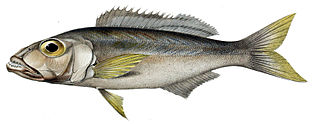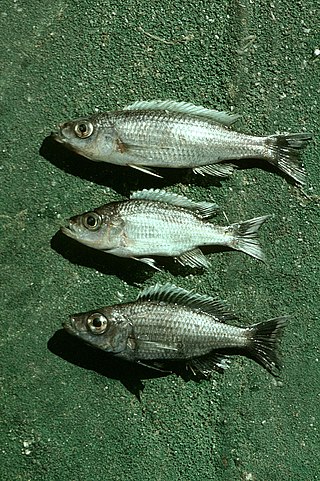
Cyprinidae is a family of freshwater fish commonly called the carp or minnow family, including the carps, the true minnows, and their relatives the barbs and barbels, among others. Cyprinidae is the largest and most diverse fish family, and the largest vertebrate animal family overall, with about 3,000 species; only 1,270 of these remain extant, divided into about 200 valid genera. Cyprinids range from about 12 mm (0.5 in) in size to the 3 m (9.8 ft) giant barb. By genus and species count, the family makes up more than two-thirds of the ostariophysian order Cypriniformes. The family name is derived from the Greek word kyprînos.

Lake Malawi, also known as Lake Nyasa in Tanzania and Lago Niassa in Mozambique, is an African Great Lake and the southernmost lake in the East African Rift system, located between Malawi, Mozambique and Tanzania.

The Tanganyika sardine is a term for two related species, both of which are small, planktivorous, pelagic, freshwater clupeid originating from Lake Tanganyika in Zambia. They form the major biomass of pelagic fish in Lake Tanganyika and Lake Malawi, swimming in large schools in the open lake, feeding on copepods and potentially jellyfish. Their major predators are four species of Lates which are also endemic to Lake Tanganyika, and are related to the Nile perch in Lake Victoria. All of these pelagic fish have suffered from overfishing in the last two decades.

Bathybates is a genus of piscivorous cichlids endemic to Lake Tanganyika in East Africa. The genus includes both pelagic species that mainly feed on Tanganyika sardines and benthic species that mainly feed on other cichlids. They are some of the deepest-living cichlids, regularly occurring down to 200 m (660 ft).

Diplotaxodon is a small genus of seven formally described, as well as a number of undescribed, deep-water species of cichlid fish endemic to Lake Malawi in east Africa. These fishes represent a remarkable adaptive radiation of offshore and deep-water adapted fish descended from ancestral shallow water forms. They include the dominant zooplankton-feeding fish of the offshore and deep-water regions of the lake, as well as a number of larger species that appear to feed on small pelagic fishes. Adult sizes range from 10 to 30 cm in total length, depending on species.

Rhamphochromis is a genus of East African haplochromine cichlids endemic to the Lake Malawi basin, also including Lake Malombe, Lake Chilingali, Chia Lagoon and upper Shire River. They mainly occur in offshore open waters, but a few species also near the coast. They are piscivores that typically feed on lake sardines and small utaka cichlids.
The dash-dot barb is a species of cyprinid fish.

Enteromius litamba is a ray-finned fish species in the family Cyprinidae. It has long been placed in Barbus, the "wastebin genus" for barbs, by default, and this is still being done by the IUCN. However, the species is increasingly being restored by some taxonomists to the related yellowfish genus Labeobarbus, others place it in the genus Enteromius. It is presumably hexaploid like the other yellowfish.
Chelaethiops minutus is a species of ray-finned fish in the family Cyprinidae. It is endemic to Lake Tanganyika and its outflow, the Lukuga River and is found in Burundi, Democratic Republic of the Congo, Tanzania, and Zambia.
Engraulicypris is a genus of fish in the family Cyprinidae endemic to Africa. In a study of mitochondrial genealogy, the species formerly included in Mesobola are not phylogenetically separated from Engraulicypris and therefore should also be included in Engraulicypris.
The Malagarasi sardine is an East African species of freshwater fish in the family Cyprinidae. It is endemic to the Malagarasi River in Burundi and Tanzania. Its natural habitats are rivers, intermittent rivers, freshwater lakes, freshwater marshes, and inland deltas. It is threatened by habitat loss.
Opsaridium microcephalum is a species of ray-finned fish in the family Cyprinidae found in Malawi, Mozambique, and Tanzania. Its natural habitats are rivers and freshwater lakes.
The lake salmon or mpasa is an African species of freshwater fish, endemic to Lake Malawi, in the family Cyprinidae found in Malawi, Mozambique, and Tanzania. Its natural habitats are rivers and freshwater lakes.
Diplotaxodon ecclesi is a species of haplochromine cichlid. It is endemic to Lake Malawi, in East Africa, where it is found in open water at mainly at the deeper levels, although it is rarely caught by trawling. Its main prey is the Lake Malawi sardine.

The Lake Tanganyika sardine is a species of freshwater fish in the family Dorosomatidae which was endemic to Lake Tanganyika but which has now been introduced to other lakes in Africa as a food source. It is monotypic within the genus Limnothrissa. It and the Lake Tanganyika sprat are known collectively as kapenta.

Usipa is a "small sardine-like fish that occurs in large shoals". Because of its small size, it is commonly dried. Usipa is mostly eaten in Malawi and Mozambique along with nsima ugali. Dried usipa is sold at most markets in Malawi. In Malawi, Usipa is typically consumed with the bones in it due to their softness.
Engraulicypris bredoi or Mesobola bredoi is an East African species of freshwater fish in the family Cyprinidae. It is endemic to Lake Albert in Uganda and the Democratic Republic of the Congo. Its natural habitats are rivers, intermittent rivers, freshwater lakes, freshwater marshes, and inland deltas. It is threatened by habitat loss.
The river sardine (Engraulicypris brevianalis or Mesobola brevianalis is an African species of freshwater fish in the family Cyprinidae. It is found in the Cunene, Okavango, upper Zambezi river systems and east coastal rivers from the Limpopo to the Umfolozi in northern KwaZulu-Natal. It is also known from the middle Luapula in Zambia. Engraulicypris gariepinus is sometimes considered conspecific.
Engraulicypris gariepinus is an African species of freshwater fish in the family Cyprinidae. It is found in the Orange River below the Augrabies Falls. It is sometimes considered conspecific with the river sardine.
Lake Malawi, also known as Lake Nyasa in Tanzania and Lago Niassa in Mozambique, is an African Great Lake and the southernmost lake in the East African Rift system, located between Malawi, Mozambique and Tanzania.









